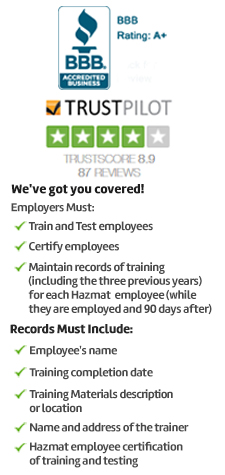_Inner_banner.jpg)
OSHA GHS Hazard Communication (Worker Right To Know)

Workers can face chemical hazards at workplaces, inside process laboratories, production floors, shops or even in the storage areas. In most of the enterprises, hazardous chemicals are found in the form of cleaning agents or supplies.
Our online OSHA GHS hazard communication course is intended to generate awareness among participants about the biological and chemical hazards that they face at workplaces and also the importance of communicating with workers about the existence of such hazards in their work areas and how to avoid such risks and work safely.
Governing regulations
Our training course has been formulated to follow employee Hazcom training or Worker Right To Know training requirements of OSHA 29 CFR § 1910.1200 Globally Harmonized System (GHS) of Classification and Labeling of Chemicals and Hazard Communication Standard.
Course Overview
This course describes the chemical, standard and physical hazards, along with hazard management that can be applied to prevent people getting affected while at work. Students also informed about various communication means to instruct workers about the presence of chemical hazards and how to protect themselves.
Who Must Take this Course?
OSHA 29 CFR 1910.1200 (C) standard stipulates that employers must provide detailed information and training to workers who are likely to be exposed to hazardous chemicals at workplaces either directly or indirectly or even for a brief period. The meaning of “Exposure” or “exposed” is that “workers can be subjected to chemical hazards during the course of their work in the form of inhalation, direct skin contact, ingestion or absorption, etc. and also accidental exposure.”
Course Format
Our OSHA Hazard Communication (Worker Right To Know) Training course has been bundled with excellent course content which includes case studies, graphical and audio presentations, self-test questions to prepare well for the final exam.
At the end of the course and after successful completion of the final exam, each candidate will be entitled to receive a hard copy of completion certificate along with a printable wallet card.
Continuing education credits?
Each successful student will get 0.2 CEUs (or 2 CMEs) for completing this e-learning course.
Topics Covered
- Introduction to Hazard Communication for General Industry
- Background Information about the Standard
- Major Changes to the Standard
- Importance of the Standard
- Key Terms
- Employer and Employee Responsibilities
- Employee Training
- Chemical Hazards
- Routes of Entry
- Recognition of Health Hazards
- Health Effects of Chemical Hazards
- Chemical Agents and Their Health Effects
- Written Hazard Communication Program
- Additional Requirements of the Written Hazard Communication Program
- Hazard Inventory
- Hazard Classification
- Health Hazard Classes
- Labels
- HMIS and NFPA Labeling Systems
- HMIS Labeling System
- NFPA Labeling System
- Safety Data Sheets
- Exposure Controls: Elimination and Substitution
- Exposure Controls: Engineering and Work Practice Controls
- Exposure Controls: Personal Protective Equipment
- Employee and Employer Rights and Responsibilities
- Employee Rights and Responsibilities
- Employer Responsibilities
- Training
- Communicating Hazards and Labeling
- Exposure Control Plan
- Elements of an Exposure Control Plan
- Housekeeping
- Sharps Injury Log
- Record Keeping
- Precautions, Controls, and Guidelines
- Universal Precautions
- Engineering and Work Practice Controls
- Needleless Systems and Engineered Sharp Protection
- General Safety Practice Review
- Personal Protective Equipment
- Available PPE
- Laundering PPE per the Bloodborne Pathogens Standard
- Removal of PPE
- Blood-borne Pathogens
- OSHA’s Blood-borne Pathogens Standard
- Requirements of the Blood-borne Pathogens Standard
- General Safety Practices
- Emergency Planning and Community Right-to-Know Act (EPCRA)
- Emergency Planning and Emergency Release Notification
- Annual Inventory
- Toxics Release Inventory
- EPCRA Inspections
- Summary
- Additional Resources
- Exam

 NEBOSH CERTIFICATE
NEBOSH CERTIFICATE NEBOSH DIPLOMA
NEBOSH DIPLOMA IOSH
IOSH SAFETY DIPLOMA
SAFETY DIPLOMA CPD UK
CPD UK ROSPA UK
ROSPA UK FOOD SAFETY
FOOD SAFETY 



